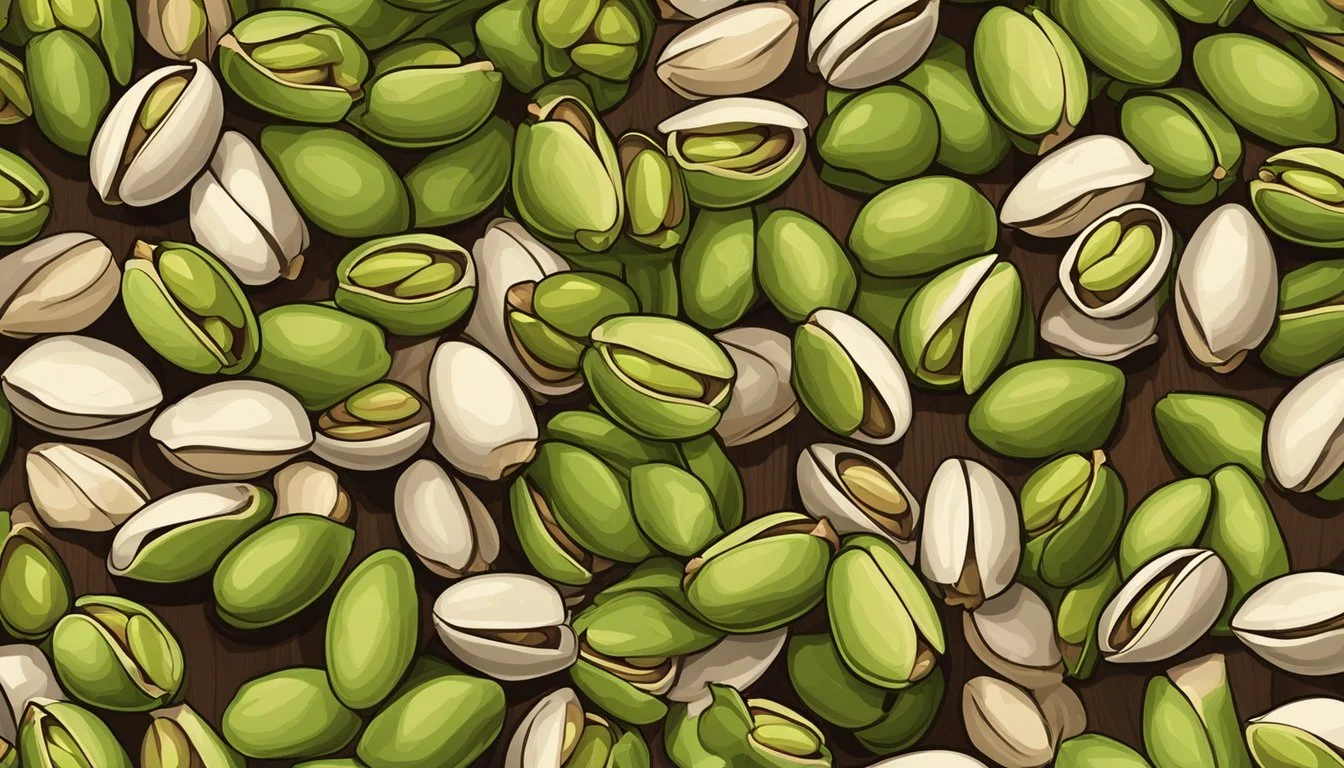Exploring Tannin-Rich Foods
Benefits and Dietary Sources
Tannins are naturally occurring compounds found in a variety of foods and beverages. Known for their astringent taste, these polyphenols play a crucial role in plant defense and human health. Understanding which foods are high in tannins can help individuals make informed dietary choices and appreciate the complexity of their nutritional benefits.
While tannins offer several health benefits, including antioxidant properties, their presence can also affect the absorption of certain nutrients. This article explores the common sources of tannins in our diet and provides insights into their impact on health.
1) Black Tea
Black tea is a widely consumed beverage known for its rich flavor and deep color. It contains the highest concentration of tannins among common teas, ranging from 11.76 to 15.14 percent. These tannins contribute to its characteristic astringency and bitterness.
Tannins in black tea have notable antioxidant properties. They help combat free radicals in the body, potentially reducing oxidative stress and contributing to overall health. Black tea tannins also exhibit anti-inflammatory effects, which may help alleviate certain inflammatory conditions.
In addition to its antioxidant benefits, black tea's tannins have antibacterial properties. These compounds can inhibit the growth of various pathogens, supporting digestive health. For example, the tannins in black tea can act against bacteria such as Helicobacter pylori, which is associated with stomach ulcers.
Despite the benefits, tannins in black tea can interfere with iron absorption. This is particularly relevant for individuals with low iron levels or specific dietary restrictions. Consuming black tea in moderation and during non-meal times can help mitigate this effect.
Black tea remains a popular choice for its robust flavor and potential health benefits. Its tannin content plays a significant role in both its taste and its health-promoting properties. Whether enjoyed hot or iced, black tea offers a unique experience with added health benefits.
2) Red Wine
Red wine is a well-known source of tannins, which contribute to its robust structure and texture.
Tannins in red wine come primarily from grape skins, seeds, and stems. During the fermentation process, these elements are in contact with the juice, imparting tannins.
Common red wine varieties with high tannin content include Cabernet Sauvignon, Malbec, Syrah, and Nebbiolo.
Tannins are responsible for the astringent and bitter taste often associated with red wine. They can make the mouth feel dry and rough.
Letting red wine "breathe" before consumption can help soften the tannins. Aeration allows tannins to react with oxygen, reducing their sharpness.
Aging red wine can also mellow the tannins over time, contributing to a smoother taste.
3) Green Tea
Green tea, known for its numerous health benefits, contains tannins, which are naturally occurring compounds found in many plants. These tannins give green tea its distinctive astringent taste and play a role in its antioxidant properties.
Green tea has a moderate level of tannins compared to other types of tea. According to research, green tea's tannin content ranges, on average, from 2.65 to 3.11 percent.
The presence of tannins in green tea contributes to its antioxidant and anti-inflammatory properties. These properties are beneficial for overall health, including potential heart health and cancer prevention benefits.
Proper brewing techniques can influence the tannin levels in green tea. Using boiling water and steeping for up to four minutes helps in maximizing the release of these beneficial compounds without making the tea overly bitter.
Consuming green tea alongside vitamin C-rich foods can enhance the body's absorption of antioxidants. Pairing green tea with foods such as lemons or strawberries may increase the health benefits experienced from drinking it.
Incorporating green tea into one's diet can be a flavorful way to benefit from the tannins and other antioxidants it provides.
4) Dark Chocolate
Dark chocolate is a well-known source of tannins.
These tannins come from the cocoa beans used in chocolate production. The higher the cocoa content, the higher the tannin content.
Dark chocolate typically has more tannins compared to milk chocolate. This is due to its higher concentration of cocoa solids.
Tannins in dark chocolate include procyanidins. These compounds have prebiotic effects.
Procyanidins selectively stimulate the growth of beneficial gut bacteria. This includes strains such as Bifidobacterium and Lactobacillus.
While tannins can sometimes be associated with astringency, they can also contribute beneficially to digestive health.
For those seeking higher tannin content, choosing dark chocolate with higher cocoa percentages is advisable. The concentration of tannins is directly proportional to the cocoa content in the chocolate.
Moderation is important, as dark chocolate can also be high in calories.
5) Pomegranate
Pomegranate is well-regarded for its high tannin content. The presence of ellagitannins, a specific type of polyphenolic compound, contributes significantly to its antioxidant properties.
These compounds are notable for their potential health benefits.
In addition to their antioxidant capacity, pomegranate tannins are thought to support brain health. They may provide protective effects against neurological conditions like Alzheimer’s and Parkinson’s diseases.
Their role in digestive health is also noteworthy.
Pomegranate’s sensory properties, including its rich color and aromatic flavor, make it a valuable ingredient in the food industry. These characteristics are largely due to its tannin content.
It is often used in juices, culinary dishes, and even as a food coloring agent.
Including pomegranate in the diet can be an effective way to reap these benefits. The fruit can be consumed fresh, juiced, or as part of various recipes.
Its versatility and array of benefits make it a popular choice among health-conscious individuals.
6) Cranberries
Cranberries are a fruit known for their high tannin content, particularly proanthocyanidins. These tannins have notable antimicrobial benefits, helping to prevent the adhesion of bacteria to the urinary tract. This characteristic reduces the risk of infections.
Cranberries are almost 90% water, with the remaining composition primarily being carbohydrates and fiber. They also provide a good amount of vitamin C.
Unripe cranberries contain higher levels of tannins, contributing to a very dry and astringent taste. This can be useful in various culinary applications, particularly in making certain types of wine.
The tannins in cranberries can also exert prebiotic effects. They selectively stimulate the growth of beneficial gut bacteria, such as Bifidobacterium and Lactobacillus. This contributes to digestive health.
7) Pistachios
Pistachios, though mostly known for their beneficial nutrients and delicious taste, also contain tannins. Tannins are compounds found in various plant-based foods that can affect the absorption of certain nutrients.
These small green nuts are rich in antioxidants, including tannins. Tannins can interfere with iron absorption when consumed in large quantities. However, the levels found in pistachios are generally considered manageable.
Roasting pistachios can slightly reduce their tannin content. Heat treatment, like roasting, is a method that can break down tannins, making iron and other nutrients more accessible.
Tannins in pistachios contribute to their slightly astringent taste. This characteristic flavor is a result of the interplay between tannins and other compounds within the nuts.
While they do contain tannins, pistachios' health benefits such as lowering blood sugar and improving heart health often outweigh potential downsides for most people.
8) Hazelnuts
Hazelnuts are a significant source of tannins, which contribute to their numerous health benefits. They are packed with essential nutrients such as healthy fats, vitamins, and minerals.
These nuts are known for their antimicrobial properties, partly due to the presence of tannins. Snacking on hazelnuts can support overall health and well-being.
The tannin content in hazelnuts may also contribute to their antioxidant properties, helping to combat free radicals in the body. This can support overall health and help protect cellular functions.
Hazelnuts are versatile and can be enjoyed in various forms, whether raw or roasted. Including them in a balanced diet can provide a delicious way to harness the benefits of tannins.
9) Red Beans
Red beans are known for their vibrant color and nutritional value. They contain high levels of tannins, which are a type of polyphenolic compound.
Tannins in red beans contribute to their antioxidant properties. These antioxidants help combat oxidative stress in the body. This can support better overall health by neutralizing harmful free radicals.
Red beans are also rich in essential nutrients. They offer a good amount of protein, fiber, and various vitamins and minerals. This makes them a well-rounded addition to any diet.
The darker color of red beans signifies a higher tannin content compared to lighter-colored beans. This higher tannin presence can affect the flavor, giving red beans a slightly astringent taste.
Soaking red beans before cooking is often recommended. This process may help reduce some of the tannin content, though its effectiveness is debatable.
Incorporating red beans into meals can be beneficial. Whether in soups, stews, or salads, they provide both nutritional benefits and enhanced flavors.
10) Walnuts
Walnuts are notable for their high tannin content. These tree nuts provide substantial health benefits due to their rich nutritional profile, which includes proteins, fibers, and polyphenols.
The antioxidants found in walnuts, including tannins, contribute to their beneficial properties. Tannins in walnuts have antibacterial characteristics which may help in fighting off infections.
Soaking or roasting walnuts can reduce their astringent taste, making them more palatable. These methods can also potentially diminish the tannin content, although their exact impact varies.
Incorporating walnuts into your diet can provide a boost of omega-3 fatty acids, further enhancing their status as a nutritious food option.
What Are Tannins?
Tannins are a class of astringent, polyphenolic compounds prevalent in many plant-based foods and beverages. These substances contribute various health benefits and possess distinct chemical structures.
Chemical Composition of Tannins
Tannins belong to a larger group called polyphenols, characterized by their bitter and astringent taste. They typically have complex molecular structures.
Hydrolyzable tannins contain central glucose molecules bonded to gallic or ellagic acids, whereas condensed tannins consist of catechin or epicatechin units. These complex structures contribute to the diverse biological activities of tannins.
Sources of tannins include tree bark, leaves, legumes, grapes, and various nuts. The molecular size of tannins can affect how they interact with other substances, influencing their potential health effects and applications.
Health Effects of Tannins
Tannins exhibit antioxidant and anti-inflammatory properties. In the digestive system, they can bind to proteins and other compounds, aiding in protection against oxidative stress.
Positive effects include potential prebiotic benefits, such as promoting the growth of beneficial gut bacteria like Bifidobacterium and Lactobacillus. This is particularly noted with foods like dark chocolate and almonds.
Negative effects may include nutrient absorption interference, particularly with iron. This inhibitory effect can be minimized by dietary adjustments, such as soaking beans to reduce tannin content.
Overall, while tannins offer significant health benefits, it is important to consider their effects in the context of an overall balanced diet.
Role of Tannins in Food
Tannins play a crucial role in defining the flavor and texture of many foods. They also offer nutritional benefits, including antioxidant and anti-inflammatory properties.
Impact on Flavor and Texture
Tannins contribute significantly to the astringent taste commonly found in certain foods. This astringency results from tannins binding to proteins in the saliva, causing them to precipitate. Foods rich in tannins include red wine, tea, and chocolate, each offering a distinct, sometimes bitter, taste.
In addition to taste, tannins impact the texture of foods. For instance, in wines and teas, tannins can create a drying sensation in the mouth. The concentration and type of tannins determine the intensity of this astringency. High-tannin beans, such as kidney and pinto beans, exhibit similar effects, though soaking can reduce tannin content.
Nutritional Benefits
Tannins offer several important nutritional benefits. They possess strong antioxidant properties, which help in neutralizing free radicals and reducing oxidative stress in the body. This can contribute to lower risks of chronic diseases, such as cardiovascular ailments and certain types of cancer.
Tannins also exhibit antimicrobial and antiviral properties. These compounds can inhibit the growth of bacteria and viruses, contributing to enhanced food safety. Furthermore, studies suggest that tannins may play a role in managing diabetes mellitus by influencing carbohydrate and lipid metabolism. These properties make tannins an important component in various plant-based foods and dietary practices.
Sources and Examples:
Food Sources Tannin Content Red Wine High Black Tea High Chocolate High Kidney Beans Moderate Pinto Beans Moderate
Overall, understanding the impact and benefits of tannins can enhance dietary choices and food preparation methods.
Processing and Cooking Tips
Incorporating foods high in tannins into meals offers both nutritional benefits and enhanced flavors. Focusing on reducing tannin levels and leveraging specific cooking methods can make these ingredients more palatable and beneficial.
Reducing Tannin Levels
Soaking foods, especially beans, can significantly reduce their tannin content. For instance, kidney beans, black grams, and mung beans benefit from this process. Soaking these legumes overnight in water helps in leaching out some of the tannins into the water, which should be discarded before cooking. Changing the soaking water multiple times can further decrease tannin levels.
Hydrothermal processing is another effective method. Boiling legumes for an extended period not only reduces tannins but also improves the availability of proteins and minerals. Combining soaking with hydrothermal methods can be particularly effective for legumes that are hard to cook.
Cooking Methods to Utilize Tannins
Different cooking methods can help maximize the health benefits of tannins in certain foods. For example, dark chocolate contains tannins that have prebiotic effects, so it can be used in recipes that don't require extensive cooking, like desserts or toppings. Similarly, incorporating spices high in tannins, such as cloves, into dishes like stews and soups can leverage their antimicrobial properties.
Roasting and dry heat cooking methods can enhance the flavor complexity of tannin-rich foods. Almonds and dark chocolate can be roasted to bring out deeper flavors while retaining beneficial tannins. Additionally, fermenting foods such as black tea can preserve tannins while adding to the product's health benefits.









